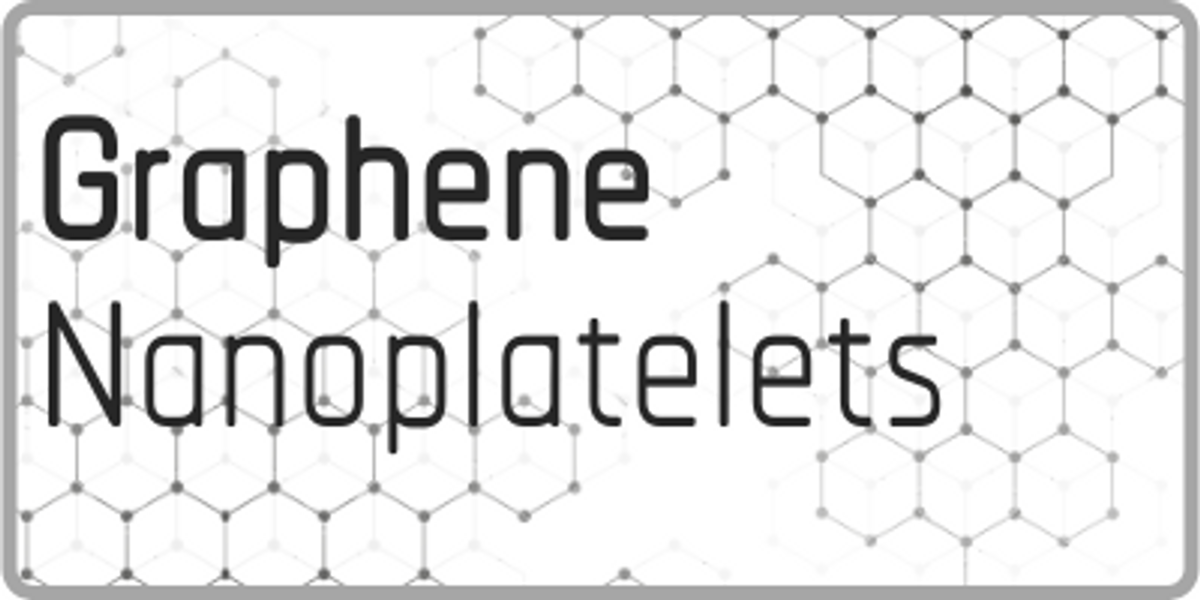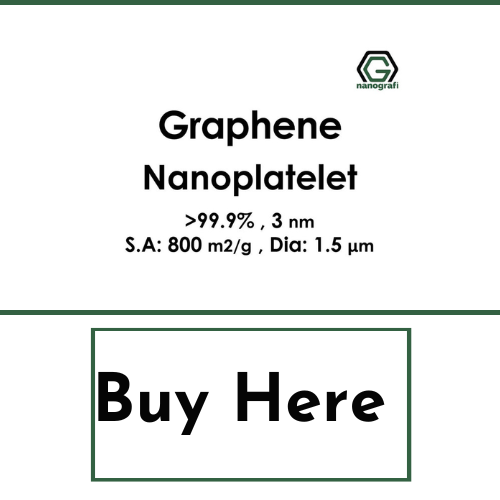Graphene Nanoplatelets: Properties and Applications
Graphene nanoplatelets with a typical density of about 8 nanometers are available in different sizes up to an estimated 51 microns.
Such fascinating nano-particles are made up of small sheets of platelet-shaped graphene, similar to the one present in carbon nano-tubes walls, though in a planar shape. It is possible to add hydrogen and covalent bonding powered by functionalization on platelet edges. Because of their unusual size and structure, the graphene nanoplatelets can attain improved barrier characteristics and enhanced mechanical properties. Thanks to their simple graphic structure, the nanoplatelets are also superb electrical and thermal conductors.
Properties of Graphene Nanoplatelets
Graphene nano-platelets possess thrilling attributes such as lightweight, wide aspect ratio, electric and thermal conductance, mechanical strength, lower cost composition, etc. They are realistic options in physics and engineering to substitute numerous nano-structured preservatives, including other carbon allotropes, steel micro-particles, or clay.
These are attractive to nano-composites because by solvent and melt counteracting, they could be quickly and effectively included within the polymer matrices. Graphene nanoplatelets are safer than carbon nano-fibers and nano-tubes and equivalent to tube-like nano-fillers in the alteration of polymers' chemical properties. In contrast, the chemical reactivity for Graphene nanoplatelets is lower than that of graphene oxide.
In view of this, in many technical areas, graphene nano-platelets are already being used. In reality, products built on Graphene nanoplatelets exhibit improved tribology, mechanical, biomedical, gas barrier, flame retardant, and properties of heat convection. In fact, Graphene nanoplatelets can turn plastic into an electrical capacitor, rendering it a perfect electronic material. Graphene nanoplatelets show a good opportunity for improving polymer matrix heat capacity, rendering them ideal as thermal interface substances.
Applications of Graphene Nanoplatelets
Graphene nanoplatelets have a variety of applications. They are used to enhance the characteristics of a wide variety of polymeric materials, including thermoplastic and thermoset composite materials, natural or synthetic rubber, thermoplastic elastomers, lubricants, paints, and coatings, due to their special nano-scale volume, form and surface structure. The graphene nano-plates are delivered in a granular shape with the correct choice of diffusion aids, devices, and techniques in water, organic solvents, and polymers.
Graphene nanoplatelets used alone can substitute traditional as well as nano-scale chemicals while extending the scope of altered properties. These are used in conjunction with other additives to reduce costs and extend the alteration of materials.
The main uses of Graphene nanoplatelets are given below
1. Improve Reliability and Thermal Conductivity
The graphene pads that make up the nanoplatelets, like all other carbon-based systems, are both thermally and electrically conductive. Nevertheless, the platelet structure, unlike nano-tubes and carbon fibers, has greater thermal touch resistance at lower load points, resulting in higher thermal conductivity than other carbon particles or fibers. Graphene nanoplatelets could be used to decrease the thermal expansion factor of most composites and to raise the intensity of maximum use. Dimensional stability and operating temperature tolerance are also improved, making polymers adjusted in thermally challenging conditions with nanoplatelets excellent for dimensional critical parts.
2. Increase in Electrical Conductivity
The graphene plates that make up these nanoplatelets are highly conductive and in most polymeric materials create an effective conductive network at low load levels. The shielding efficiency is usually attained in thermoset resins at charging rates of 2-3 wt percent and in thermoplastics at 5-7 wt percent. Furthermore, unlike so many permeable compounds, such nanoplatelets may not adversely affect the mechanical or esthetic properties of the base material, and neither are they abrasive tools as can be metal flake or fabric.
3. Reduction of Porousness
The graphene nano-platelets dramatically reduce the permeability and scattering coefficients of a composite content when compressed into a polymer film or solid component. The platelets' high aspect ratio–which is much larger than they are dense makes them efficient at low load speeds- significantly reduces costs and effects on other properties. Permeability is significantly affected by the additive's particle size, and large diameter particles typically have lower absorption reductions.
Moreover, electrical equipment are built on flexible synthetic materials. As a way to create elastic and compatible conductive materials, the combination of mechanical properties of polymers and conductive nano-fillers is exciting. However, the high price of nano-silver restricts its huge-scale production. Due to their versatility and low surface toughness, carbon-based conductive nano-fillers, and graphene nanoplatelets, in general, received greater attention as products for versatile devices.
The functionalization of stretchable thin films with Graphene nanoplatelets-based conductive ink is another exciting approach to versatile electronics. In fact, the device's sensing capacity was strengthened after the addition of graphene nanoplatelets. In contrast, Graphene nanoplatelets reduced the sample's active surface area and boosted the electron interaction between the sample and ammonia gas.
To find out more, you can read Ultimate Guide to Graphene: Everything You Need to Know About Graphene.
Researchers are working on versatile electronic devices based on Graphene nanoplatelets. They began using PTFE membranes to trap graphene diffusion and used a transfer printing process (a basic pen) to move the conductive nanoparticle to paper. There weren't enough numerous folding cycles to affect the electrical conductivity of the material. However, such composite Graphene nanoplatelets-paper retained about 90 percent of the initial electrical conductivity after 1000 cycles of 180 degrees capable rolling.
The development of functional and bendable electronics moves to unconventional configurations of materials to design circuits on curvilinear or deformable structures/microbes, and to produce flexible electrical devices and sensors. The pairing of a moldable or elastomeric substrate with a permeable nano-material is a desirable method for the development of compatible electronic nano-composites. Sensor systems manipulate the permeability and capacity variances documented when deforming such nano-composites. Such variants are used in devices such as stress, pressure, and tactile receptors as feedback mechanisms. Usually, permeable nano-fillers within the framework are isolated and associated further with external stimuli (often mechanical), altering the electrical characteristics of the material.
Polydimethylsiloxane (PDMS) is a common substrate for pressure detectors due to its strength, stretching ability and manufacturing ease. Together with Graphene nanoplatelets, a study were examined for PDMS related pressure detectors. This machine achieved a gauge factor of roughly 235 at a concentration of approximately 8 vol each, and approximately 2 percent within a pressure. A conductive and elastic film has also been developed by pressing Graphene nanoplatelets mechanically onto a medical tape and embedding the structure inside PDMS.
Importance of Graphene Nanoplatelet
Graphene Nanoplatelets are of huge importance because of their peculiar characteristics. Versatile devices centered on Graphene nanoplatelets have been fully investigated and seems to have already had a major impact. There have been many different methods proposed; two exceptions are the free-standing of Graphene nanoplatelets films and the use of Graphene nanoplatelets in polymers. Nonetheless, by functionalizing flexible plastic substrates with pure nano-flakes and conductive inks with polymer-Graphene nanoplatelets, the most promising results have been achieved so far.
Adaptable devices based on Graphene nanoplatelets have been thoroughly researched and seems to have already had a significant impact. There have been many different approaches proposed; two exceptions are the free-standing of Graphene nanoplatelets films and the use of Graphene nanoplatelets in polymers. Nonetheless, by functionalizing flexible plastic substrates with pure nano-flakes and conductive inks with polymer-Graphene nanoplatelets, the most promising results have been achieved so far. Scientists collected robust and high-performance equipment such as antennas, compatible electrical electrodes for power applications, and lightweight electromagnetic resistance films with such approaches.
In addition, the widespread use of cellulose thin films, often combined with biopolymers, has proven fruitful for the development of durable, versatile Graphene Nanoplatelets-based technologies and for environmentally friendly electronic waste management. On the other hand, intelligent sensors focused at Graphene nanoplatelets have also achieved encouraging development. As portable sensing technology of future generation, they maintain stretching ability and flexible electrical characteristics that appear to have made a significant impact. To date, the synthesis of PDMS and Graphene nanoplatelets has been mostly studied, but other elastomeric products such as thermoplastic polyurethanes, rubbers, and gel-like structures such as dumb putty are considered possibilities. The proliferation of Graphene nanoplatelets-based intelligent detectors would support applications such as tactile apps and digital robotic skins. In general, as graphene-based material has experienced one of the highest gage factors ever recorded, strain sensing mechanisms have evolved for many applications, ranging from structural and human health monitoring to automotive and sports applications.
Lastly, recent developments indicate composite materials of the Graphene nanoplatelets-reinforced biopolymer. Consumer products such as skis and pneumatics are now obtained from the use of Graphene Nanoplatelets in oil-derived polymers. But the need to improve biopolymers has also arisen lately as a technique to bridge the achievement gap between conventional long-lasting polymers and bioplastics. Broader use of biopolymers are also intended for structural purposes through these techniques. PLA is the bio-plastic most studied in conjunction with Graphene nanoplatelets. It has shown satisfactory results. The use of Graphene nanoplatelets-reinforced PLA 3D printing filaments is now possible. In comparison, the successful use of Graphene nanoplatelets within other bio-polyesters and cellulose-based products requires additional efforts.
Conclusion
Thus, Graphene is considered to be the 21st-century revolutionary element. Many Graphene-family goods now industrially accessible are increasing on the market because there is no suitable mass production process so far. Graphene nanoplatelets, in general, are attracting increasing interest due to their nano-powder form and compelling chemo-physical properties, making them a material of choice for advanced nanocomposites. In this study, they focused primarily on developing fields dependent on Graphene nanoplatelets, such as mobile and wearable electronics, intelligent sensing, and enhanced bio-composites. Given all the findings and potential future innovations, we conclude that Graphene nanoplatelets will continue to develop through branding and industrialization in the future.
To discover the latest articles in graphene products, you can visit Blografi.
References
1.Kuan, C. F. et al. Characterization and properties of graphene nanoplatelets/XNBR nanocomposites. Polym. Polym. Compos.26, 59–67 (2018).
2.Cataldi, P., Athanassiou, A. & Bayer, I. S. Graphene nanoplatelets-based advanced materials and recent progress in sustainable applications. Appl. Sci.8, (2018).
3.Geim, A. K. & Novoselov, K. S. The rise of graphene. Nat. Mater.6, 183–191 (2007).
4.Royal, T. H. E., Academy, S. & Sciences, O. F. compiled by the Class for Physics of the Royal Swedish Academy of Sciences Graphene. 50005, 0–10 (2010).
Recent Posts
-
Nanocomposites in Food Packaging
The utilization of nanocomposites in food packaging represents a significant advancement in the fiel …19th Apr 2024 -
What is the Difference Between 7075 and 6061 Aluminum Alloy?
When comparing 7075 aluminum alloy to 6061 aluminum alloy, it's essential to understand their disti …5th Apr 2024 -
Iron-Air Batteries: The Ultimate Guide
Iron-air batteries represent a significant breakthrough in energy storage technology, offering a sus …29th Mar 2024







